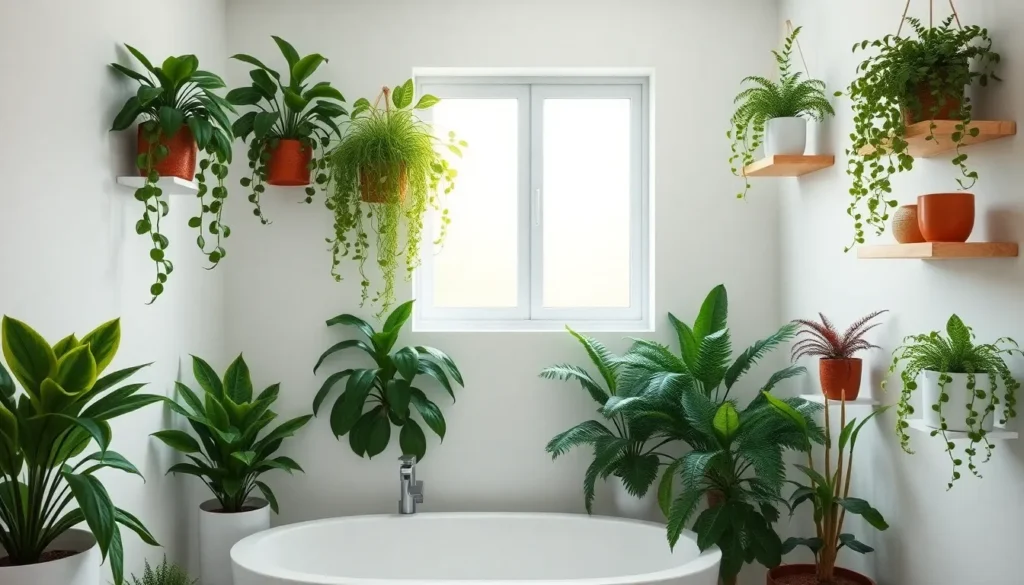We’ve all been there – staring at our windowless bathroom wondering if it’s possible to bring some life into this sterile space. You might think plants can’t survive in a bathroom without natural light but we’re here to prove you wrong.
The truth is plenty of gorgeous plants actually thrive in low-light humid environments. Your windowless bathroom could become a lush green sanctuary with the right plant choices. These hardy beauties don’t just survive – they flourish in the steamy conditions that most plants would find challenging.
Ready to transform your bathroom into a spa-like retreat? We’ll show you exactly which plants love dark humid spaces and how to keep them happy. From air-purifying powerhouses to trailing beauties that’ll cascade from your shelves these low-light champions are about to change everything you thought you knew about bathroom gardening.
Best Low-Light Plants That Thrive in Windowless Bathrooms
We’ve selected these exceptional plants because they naturally adapt to dim environments while tolerating the humidity fluctuations common in bathrooms. Each variety offers unique benefits that make windowless bathroom gardening both achievable and rewarding.
Snake Plant (Sansevieria)
Snake plants stand as our top recommendation for windowless bathrooms because they tolerate extremely low light conditions while requiring minimal water. These architectural beauties feature thick, upright leaves with striking yellow borders that add instant visual interest to any bathroom corner.
Benefits include air purification capabilities that remove formaldehyde and benzene from bathroom air, plus their ability to release oxygen at night. Maintenance requires watering only every 2-3 weeks, making them perfect for busy schedules. Growth patterns show these plants can reach 3-4 feet tall in bathroom conditions, creating dramatic vertical elements without spreading horizontally.
Placement works best on bathroom floors, countertops, or tall plant stands where their upright structure won’t interfere with daily routines. We recommend the compact varieties like Sansevieria trifasciata ‘Hahnii’ for smaller spaces or the dramatic Sansevieria cylindrica for larger bathrooms.
ZZ Plant (Zamioculcas Zamiifolia)
ZZ plants excel in windowless bathrooms because their waxy leaves reflect available light while storing water for extended periods. These glossy green specimens bring tropical elegance to sterile bathroom environments without demanding constant attention.
Durability makes ZZ plants nearly indestructible, surviving weeks without water and thriving in artificial bathroom lighting. Growth habits show these plants develop slowly but steadily, reaching 2-3 feet in height with multiple stems that create full, bushy appearances. Air cleaning properties help remove xylene and toluene commonly found in bathroom cleaning products.
Watering needs occur only when soil completely dries out, typically every 3-4 weeks in bathroom humidity. Propagation happens easily through leaf cuttings, allowing you to create multiple plants from one original specimen. We suggest placing ZZ plants on bathroom vanities or in corners where their architectural form can serve as living sculpture.
Pothos
Pothos varieties transform windowless bathrooms into green sanctuaries because their trailing vines adapt beautifully to hanging displays and shelf arrangements. These versatile climbers offer multiple color variations including golden, marble queen, and neon varieties that brighten dim bathroom spaces.
Versatility allows pothos to grow in water or soil, making them perfect for bathroom propagation projects and creative displays. Growth rate shows these plants can extend 6-10 feet when given proper support, creating dramatic cascading effects from high shelves or ceiling hooks. Humidity tolerance makes bathroom environments ideal for pothos, as they naturally thrive in moisture rich conditions.
Training options include letting vines trail naturally, wrapping them around bathroom mirrors, or training them up moss poles for vertical interest. Maintenance involves pinching back growth to maintain desired length and removing any yellowing leaves. We recommend golden pothos for beginners because they show the most resilience in challenging windowless conditions.
Peace Lily
Peace lilies bring elegant white blooms to windowless bathrooms while serving as natural humidity indicators through their responsive leaf behavior. These sophisticated plants signal watering needs by drooping slightly, making bathroom plant care intuitive and rewarding.
Flowering occurs regularly in bathroom humidity, producing white spathes that last 4-6 weeks and create spa like ambiance. Air purification removes ammonia, formaldehyde, and acetone commonly present in bathroom environments, improving overall air quality. Size options range from compact 12-inch varieties perfect for countertops to dramatic 3-foot specimens suitable for floor placement.
Watering requirements involve keeping soil consistently moist but not waterlogged, typically requiring water every 5-7 days in bathroom conditions. Light adaptation shows peace lilies adjust well to artificial bathroom lighting while producing fewer but larger blooms. We position these plants where their drooping leaves can serve as natural watering reminders while their blooms provide focal points in bathroom design.
Artificial Lighting Solutions for Your Bathroom Plants
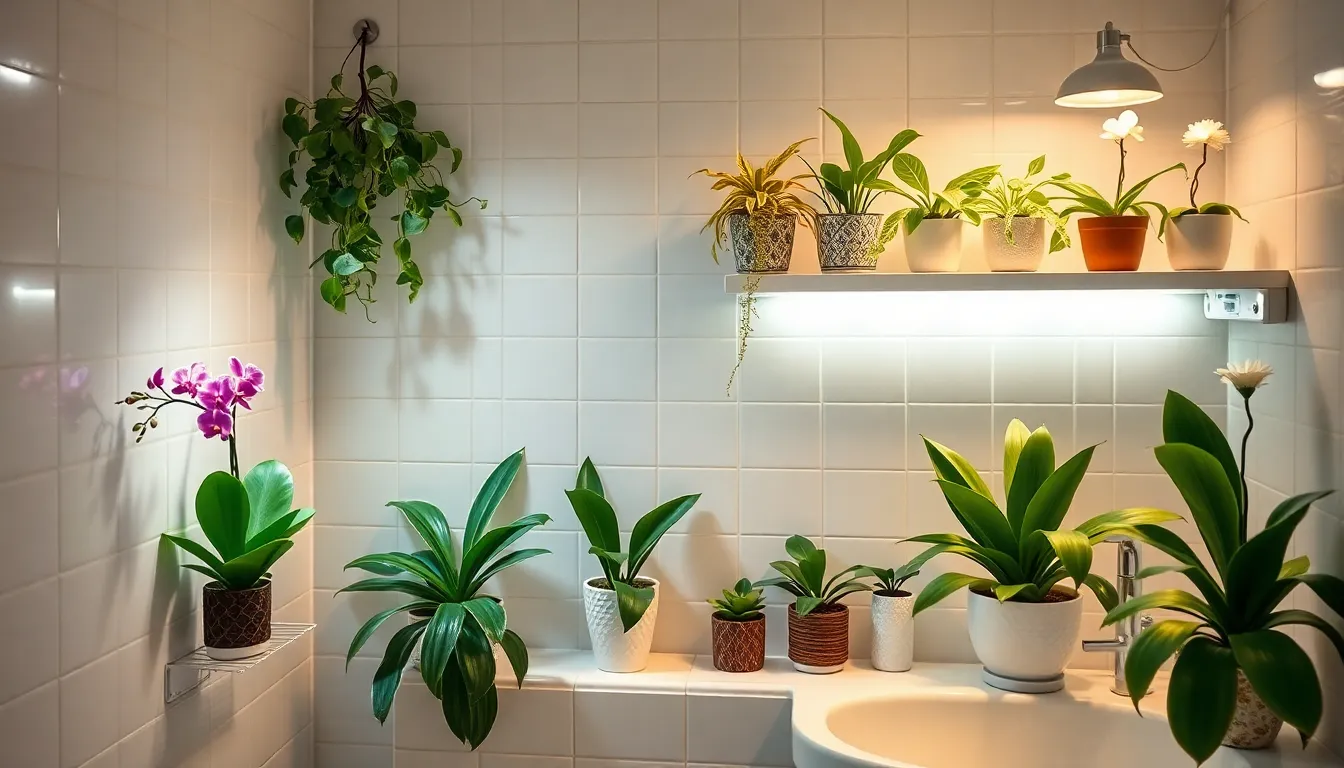
Now that you’ve selected your perfect windowless bathroom plants, we need to ensure they receive adequate light to thrive. The right artificial lighting system transforms your bathroom into an optimal growing environment.
LED Grow Lights
LED grow lights represent our top recommendation for bathroom plant care due to their exceptional energy efficiency and minimal heat production. These full spectrum lights mimic natural sunlight by promoting photosynthesis and healthy growth even in completely windowless spaces. Modern LED systems feature optical lens systems that deliver high photosynthetic photon flux density (PPFD), ensuring your plants receive concentrated light exactly where they need it.
We particularly recommend adjustable LED options like SANSI full spectrum clip grow lights and Glowrium Grow Light, which accommodate various plant sizes through their flexible positioning arms. Your jewel orchids will thrive with 10-12 hours of daily LED exposure, while other bathroom plants benefit from similar consistent lighting schedules. The long lifespan of LED systems makes them cost effective for continuous bathroom use.
Fluorescent Plant Bulbs
Fluorescent lights provide an excellent balance of light spectrum and intensity for indoor bathroom plants. These bulbs produce adequate illumination with moderate heat output, making them ideal for delicate plants in humid bathroom environments. Compared to traditional incandescent options, fluorescent plant bulbs deliver superior performance without overheating your bathroom space.
We find fluorescent systems particularly effective for larger plant collections where you need broader light coverage. The consistent light distribution helps multiple plants receive uniform illumination throughout your bathroom setup.
Timer-Controlled Lighting Systems
Timer controlled lighting eliminates the guesswork from your bathroom plant care routine. These automated systems ensure your plants receive consistent photoperiods necessary for healthy growth cycles without requiring daily manual intervention. We recommend combining timers with smart sensors to create IoT enabled systems that monitor humidity, soil moisture, and light intensity.
Advanced timer systems can mimic natural circadian rhythms, optimizing light exposure throughout the day and night cycles. Integration with smart sensors prevents overwatering while maintaining ideal growing conditions, particularly beneficial for humidity loving plants like peace lilies in your windowless bathroom environment.
Humidity-Loving Plants Perfect for Steamy Bathrooms
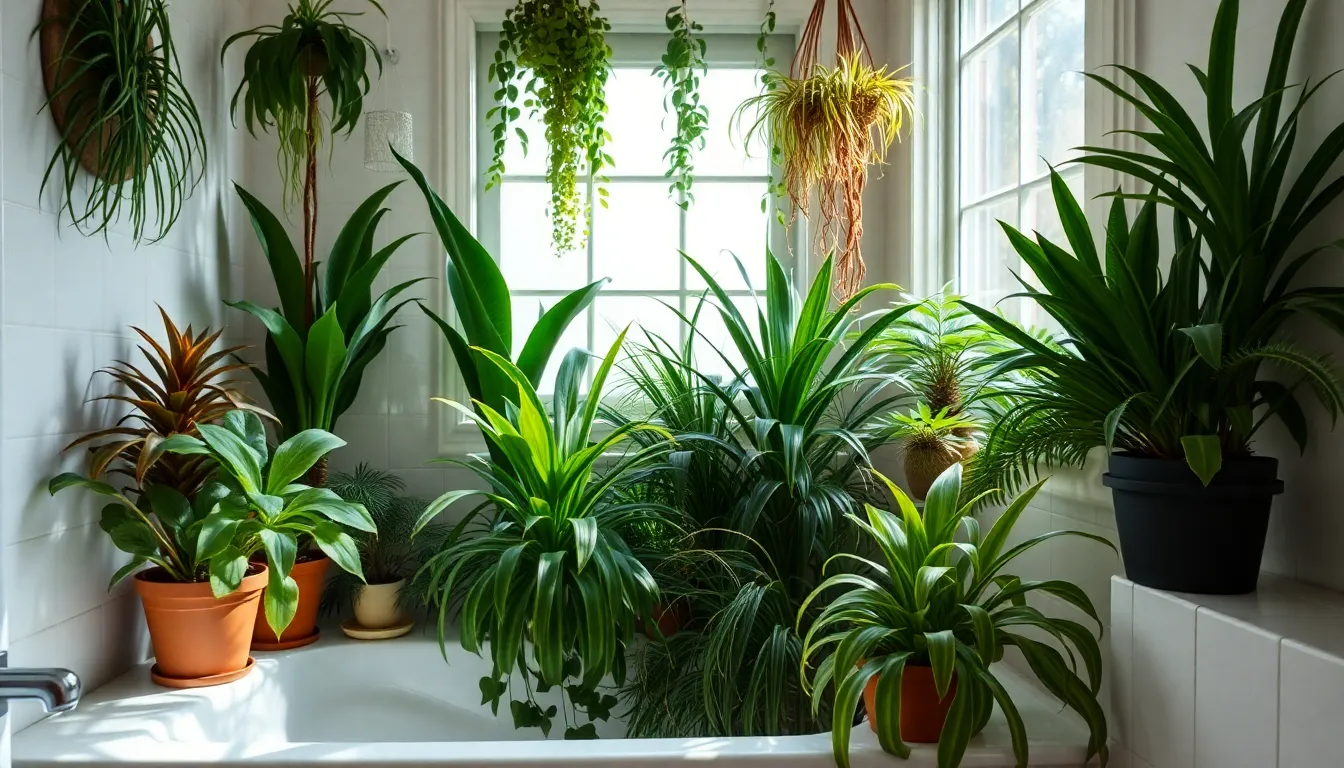
Steam from daily showers creates the perfect microclimate for plants that naturally thrive in tropical conditions. These humidity loving species will transform your windowless bathroom into a lush retreat.
Boston Fern
Boston Ferns absolutely love the consistent moisture that steamy bathrooms provide. Their feathery fronds create a vibrant green cascade that adds natural beauty while improving your bathroom’s air quality. We recommend placing these ferns on bathroom shelves or in hanging planters where they can benefit from the humid air without getting waterlogged.
Consistent humidity keeps Boston Fern fronds lush and prevents the brown, crispy edges that develop in dry environments. These plants tolerate low light conditions exceptionally well, making them ideal candidates for windowless spaces. Regular misting isn’t necessary when you place them in bathrooms since shower steam provides all the moisture they need.
Air Plants (Tillandsia)
Air Plants absorb moisture and nutrients directly from humid bathroom air, eliminating the need for soil entirely. These unique specimens thrive in steamy environments where traditional houseplants might struggle with root rot. We love how their sculptural forms create living art pieces that require minimal maintenance.
Soaking Tillandsia plants once weekly keeps them healthy and vibrant in bathroom settings. Bright indirect light helps them flourish, though artificial lighting works perfectly in windowless bathrooms. Their diverse shapes and sizes make them perfect for creating eye catching displays on bathroom counters, shelves, or mounted on walls.
Chinese Evergreen
Chinese Evergreen plants excel in very low light conditions, even thriving in completely windowless rooms. Their attractive variegated leaves add stunning color patterns and texture to bathroom spaces. We appreciate how these plants prefer humid environments and moderate watering schedules that align perfectly with bathroom conditions.
Aglaonema species tolerate the fluctuating humidity levels that occur in bathrooms throughout the day. Their colorful foliage remains vibrant even in artificial lighting, making them excellent choices for adding visual interest to windowless spaces. Regular bathroom humidity eliminates the need for additional misting or humidity trays.
Cast Iron Plant
Cast Iron Plants earn their name through incredible toughness and ability to withstand challenging growing conditions. These hardy specimens tolerate low light and irregular watering better than almost any other houseplant. We recommend them for busy homeowners who want bathroom greenery without high maintenance requirements.
Aspidistra elatior benefits tremendously from consistent bathroom humidity, which keeps its broad dark green leaves looking healthy and lustrous. Its tolerance for neglect makes it perfect for bathrooms where you might forget regular plant care routines. The plant’s substantial foliage creates an impressive tropical appearance that transforms sterile bathroom spaces into natural sanctuaries.
Creative Placement Ideas for Plants in Windowless Bathrooms
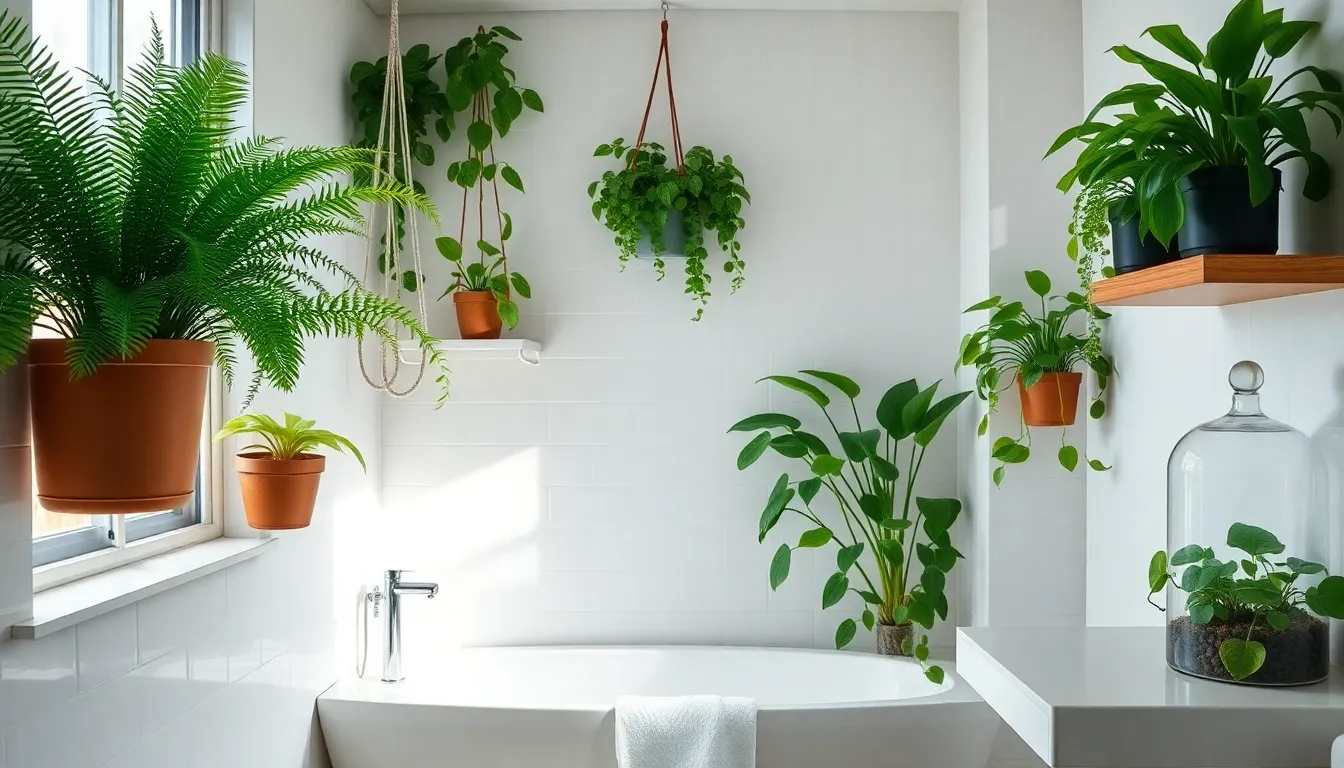
Now that we’ve covered the best plants for windowless bathrooms, let’s explore strategic placement methods that maximize both visual impact and plant health. Smart positioning transforms your space into a verdant oasis while working within the constraints of limited light and space.
Hanging Planters from Ceiling
Hanging planters create dramatic vertical interest while saving precious floor and counter space in compact bathrooms. We recommend positioning Boston ferns in ceiling-mounted planters to showcase their cascading fronds, which naturally drape downward for a flowing green effect. This placement allows the humidity from your shower to rise and nourish the plants naturally.
Macrame hangers work particularly well for lighter plants like air plants and small pothos varieties. Install ceiling hooks near your shower area where steam concentrates, but ensure they’re positioned away from direct water spray. We suggest using adjustable rope systems so you can easily lower plants for maintenance and watering.
Floating Shelves and Wall-Mounted Options
Wall-mounted shelves maximize vertical space while creating eye-level greenery that enhances your bathroom’s aesthetic appeal. We recommend installing floating shelves at varying heights to accommodate different plant sizes and create visual depth. Small ferns, compact Chinese Evergreens, and moss art pieces work exceptionally well on these elevated surfaces.
Corner shelves use often-overlooked spaces and can support trailing plants like pothos that drape naturally along bathroom walls. Consider installing shelves with built-in lighting underneath to provide supplemental illumination for your plants. We find that glass shelves reflect available light while maintaining a clean, spa-like appearance.
Floor-Standing Plant Stands
Floor-standing plant stands elevate larger specimens and create striking focal points in empty bathroom corners. We recommend tiered stands that accommodate multiple plants at different heights, maximizing your growing space while maintaining visual balance. Chinese Evergreens and larger ZZ plants particularly benefit from this elevated positioning.
Rolling plant stands offer flexibility, allowing you to move plants closer to artificial light sources or shower areas as needed. Choose stands with moisture-resistant materials like bamboo or treated wood that can withstand bathroom humidity. We suggest positioning taller plants near the back of your bathroom to create depth without blocking pathways.
Shower Niche Displays
Shower niches provide perfect microclimates for humidity-loving plants while adding spa-like ambiance to your bathing experience. We recommend placing small Boston ferns or air plants in these recessed areas where they can benefit from consistent moisture without direct water contact. These built-in displays create living art that transforms your shower into a natural sanctuary.
Consider using waterproof plant containers or glass terrariums to protect plant roots from excess water while maintaining the humid environment they crave. We find that rotating plants between shower niches and other bathroom locations helps prevent overwatering while ensuring they receive adequate moisture. Small trailing plants like baby pothos can cascade beautifully from upper niches, creating natural curtains of greenery.
Essential Care Tips for Bathroom Plants Without Natural Light
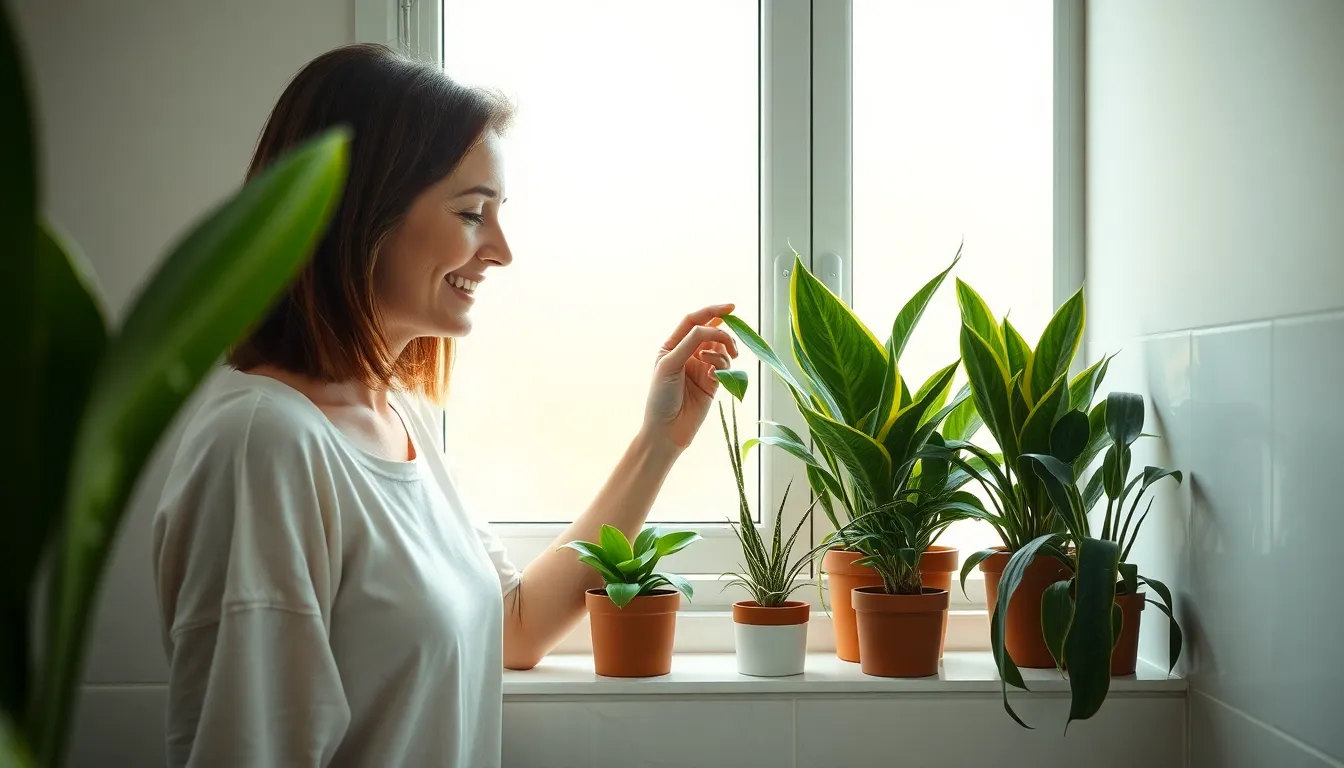
Caring for plants in windowless bathrooms requires adjusting our traditional gardening approach to accommodate the unique low light and high humidity environment. We’ll need to modify watering schedules, fertilizing routines, and maintenance practices to ensure our green companions thrive in these challenging conditions.
Watering Schedule Adjustments
Reduce watering frequency significantly compared to plants in bright areas since low light conditions slow plant metabolism and water uptake. We recommend allowing soil to dry completely between watering sessions to prevent the most common issue: root rot.
Water ZZ plants every 2-3 weeks rather than weekly, as these hardy specimens are particularly susceptible to overwatering in dim conditions. Snake plants and spider plants also benefit from this “less is more” approach, thriving when we let soil dry between waterings.
Check soil moisture by inserting your finger 1-2 inches deep before watering. We’ve found that bathroom humidity can create misleading surface moisture, making this depth test essential for accurate assessment.
Monitor for overwatering signs like yellowing leaves, musty soil odor, or soft stems. These symptoms appear more quickly in low light environments where plants can’t process excess water efficiently.
Fertilizing Requirements
Fertilize sparingly since plants in low light conditions grow slower and require fewer nutrients than their bright light counterparts. We suggest reducing fertilizer application to once every 1-2 months during the growing season.
Use diluted houseplant fertilizer at half the recommended strength to avoid overwhelming stressed plants. Over-fertilizing can cause more harm than good when plants are already adapting to challenging light conditions.
Skip winter fertilizing entirely, as most plants enter dormancy periods and can’t process additional nutrients effectively. We resume feeding only when new growth appears in spring.
Choose balanced fertilizers with equal N-P-K ratios rather than high-nitrogen options that promote excessive leaf growth in already dim conditions.
Rotation and Maintenance
Rotate plants weekly by moving them to medium light areas outside the bathroom for 1-2 days maximum. This prevents relocation shock while providing essential light exposure without risking leaf burn from sudden bright light.
Install grow lights with appropriate wavelengths if rotation isn’t practical, keeping bathroom lights on when possible to supplement available illumination. LED grow lights work best for consistent, energy-efficient supplementation.
Dust leaves regularly using a damp cloth to remove buildup that blocks light absorption and reduces the plant’s ability to photosynthesize effectively. Clean leaves also improve moisture retention in humid bathroom environments.
Prune dead or yellowing foliage immediately to prevent fungal issues that thrive in humid, low light conditions. We remove damaged leaves at the base using clean scissors to maintain plant health and appearance.
Common Mistakes to Avoid When Growing Plants in Windowless Bathrooms
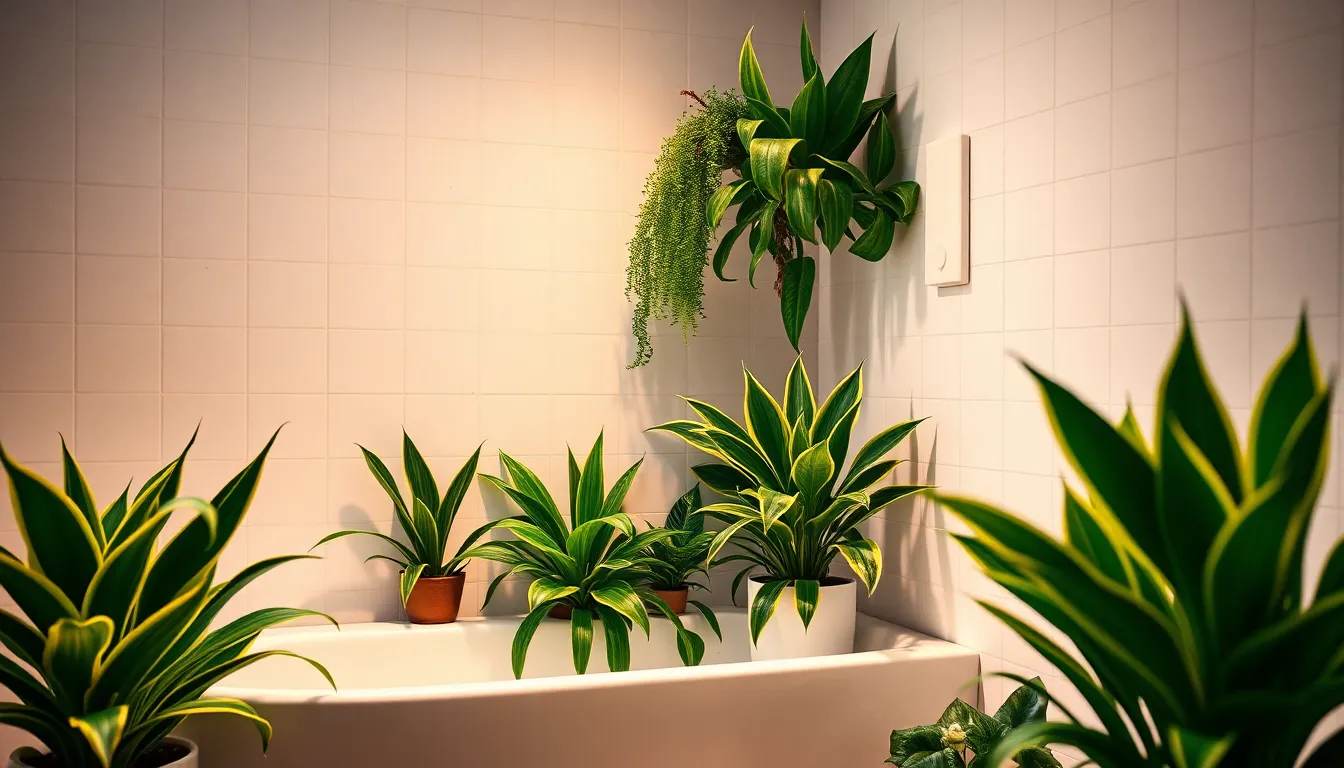
Even with the right plant selection and care strategies, certain pitfalls can derail your windowless bathroom garden. We’ve identified the most critical mistakes that prevent plants from thriving in these challenging conditions.
Overwatering Due to High Humidity
Overwatering ranks as the top killer of bathroom plants, especially when we underestimate how humidity affects watering needs. Windowless bathrooms maintain consistently high moisture levels that significantly reduce how much water plants actually require.
ZZ plants and Snake plants are particularly susceptible to root rot when we water them on the same schedule as plants in drier rooms. These drought tolerant species need watering only when their soil completely dries out, which can take 2-3 weeks in humid bathroom conditions.
We recommend checking soil moisture with your finger before watering any bathroom plant. Most humidity loving plants need 30-50% less water than they would in typical indoor environments. Yellowing leaves and mushy stems often signal overwatering damage that could have been prevented with less frequent watering.
Choosing Light-Dependent Plants
Many popular houseplants demand natural or artificial light that simply isn’t available in windowless spaces. We see gardeners repeatedly select beautiful flowering plants or colorful foliage varieties that require bright indirect light to survive.
Plants like fiddle leaf figs, monstera deliciosa, and most succulents will struggle and eventually die without adequate light exposure. These species need consistent photosynthesis that low light conditions cannot support, leading to leggy growth and leaf drop.
Focus exclusively on proven low light tolerant species when selecting plants for windowless bathrooms. Snake plants, ZZ plants, cast iron plants, and certain ferns have evolved to thrive in minimal light conditions. We avoid any plant labeled as needing “bright” or “medium” light unless we’re installing supplemental grow lights.
Poor Ventilation Issues
Stagnant air creates the perfect breeding ground for mold, mildew, and fungal diseases that can quickly destroy bathroom plants. Even though high humidity benefits many species, we need adequate airflow to prevent these harmful conditions.
Bathrooms with poor ventilation trap moisture around plant leaves, creating conditions where fungal spores multiply rapidly. We’ve observed black spots, powdery mildew, and root rot developing within days in poorly ventilated spaces.
Installing an exhaust fan or ensuring existing ventilation works properly becomes essential for plant health. We recommend running fans for 30 minutes after showers and keeping bathroom doors open when possible. Small oscillating fans can also improve air circulation around plants without creating drafts that might stress them.
Budget-Friendly Plant Options for Your No-Window Bathroom
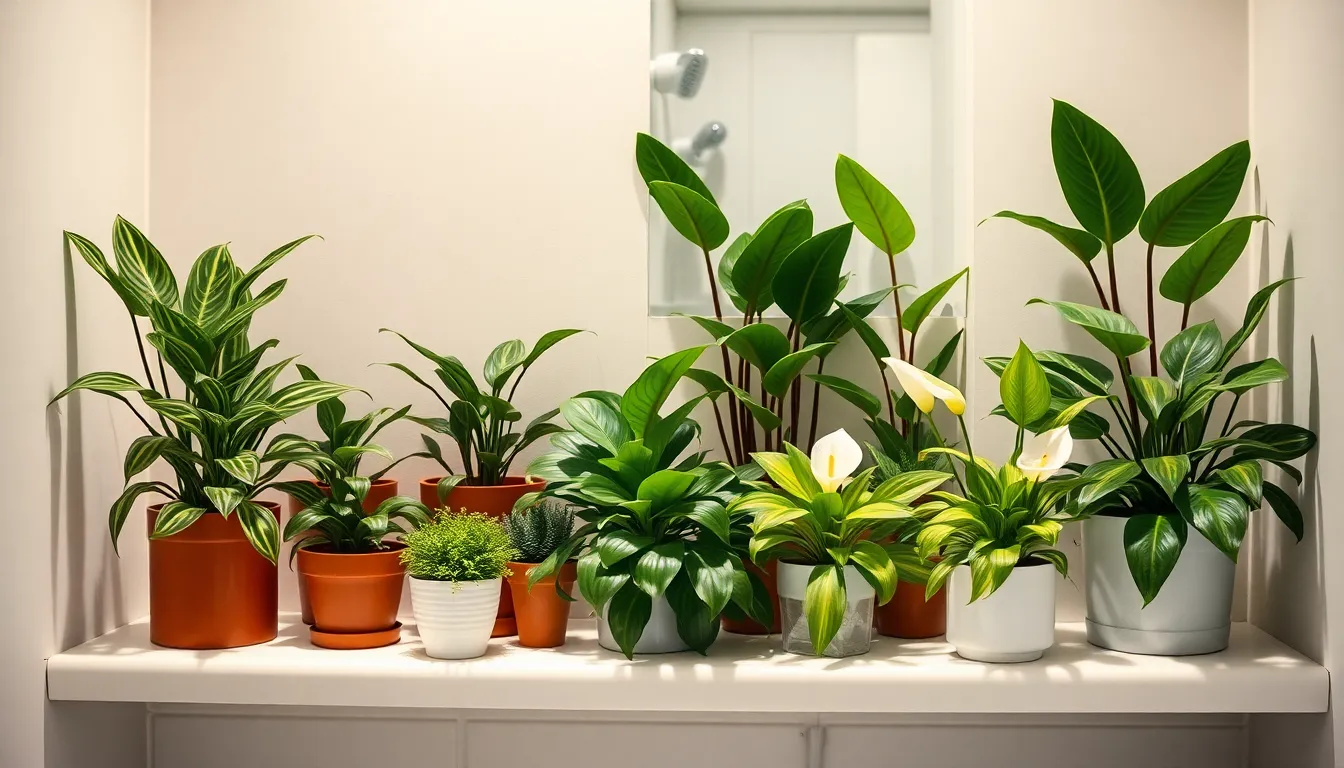
Creating a lush bathroom oasis doesn’t require very costly. We’ve discovered several cost-effective approaches that make windowless bathroom gardening accessible to everyone.
Propagated Cuttings
Propagated cuttings offer the most economical way to fill your windowless bathroom with greenery. Many low-light tolerant plants root easily from cuttings, allowing us to multiply our collection without purchasing mature specimens. ZZ plants propagate exceptionally well from leaf cuttings, developing new shoots within 2-3 months when placed in water or moist soil.
Snake plants multiply through leaf cuttings or division, creating multiple plants from a single parent. Pothos and Philodendron cuttings root within 1-2 weeks in water, making them perfect candidates for budget-conscious plant lovers. We recommend starting with 4-6 inch cuttings for the best success rates in low-light conditions.
Small Starter Plants
Starting with small plants reduces initial costs while providing better adaptation to challenging bathroom environments. Young plants typically cost 30-50% less than mature specimens and adjust more readily to low-light conditions than their fully grown counterparts. Small Peace Lilies in 4-inch pots adapt beautifully to humid bathrooms and indicate their needs through leaf drooping.
Baby ferns like Bird’s Nest Fern and Blue Star Fern thrive when purchased as starter plants, gradually developing their full foliage as they acclimate. We’ve found that 2-3 inch starter ZZ plants establish stronger root systems in artificial lighting compared to larger transplants.
Low-Maintenance Varieties
Low-maintenance plant varieties ensure success even for beginners working with challenging windowless conditions. ZZ plants tolerate complete neglect, requiring water only every 2-3 weeks while thriving under fluorescent bathroom lighting. Snake plants handle both drought and humidity extremes, making them virtually indestructible in bathroom environments.
Cast Iron plants live up to their name by withstanding temperature fluctuations and irregular care schedules common in bathroom settings. Chinese Evergreens provide attractive variegated foliage while tolerating low light and requiring minimal attention beyond monthly watering checks. These hardy varieties cost between $8-15 for starter plants, delivering maximum value for your windowless bathroom transformation.
Conclusion
Creating a thriving plant collection in your windowless bathroom is absolutely achievable with the right approach. We’ve shown you that low-light champions like Snake Plants ZZ Plants and Boston Ferns can transform your space into a green sanctuary.
The key lies in understanding your plants’ needs and adapting your care routine accordingly. With proper LED grow lights strategic placement and adjusted watering schedules your bathroom can become the humid paradise these plants crave.
Remember that success doesn’t require a big budget or extensive gardening experience. Start small with propagated cuttings or budget-friendly options and watch your confidence grow alongside your plants.
Your windowless bathroom holds incredible potential for becoming a lush retreat that purifies your air and soothes your senses every day.
Frequently Asked Questions
Can plants really grow in a windowless bathroom?
Yes, plants can thrive in windowless bathrooms with proper care and lighting. Many varieties like Snake plants, ZZ plants, and Pothos are naturally adapted to low-light conditions and actually benefit from the high humidity found in bathrooms. LED grow lights can supplement natural light to ensure healthy growth.
What are the best plants for a windowless bathroom?
Snake plants, ZZ plants, Pothos, Peace Lily, Boston Fern, and Cast Iron plants are excellent choices. These varieties tolerate low light and high humidity conditions while requiring minimal maintenance. They also offer air-purifying benefits and can transform your bathroom into a lush, spa-like retreat.
Do I need special lighting for bathroom plants?
LED grow lights are highly recommended for windowless bathrooms. They’re energy-efficient, produce minimal heat, and can mimic natural sunlight. Fluorescent plant bulbs are also effective. Timer-controlled systems help automate light exposure, ensuring your plants receive consistent illumination for 12-16 hours daily.
How often should I water plants in a windowless bathroom?
Water less frequently than usual due to high humidity. Most bathroom plants need watering only when the top inch of soil feels dry. Snake plants and ZZ plants may only need water every 2-4 weeks, while tropical varieties like Boston ferns require more frequent watering.
Where should I place plants in my windowless bathroom?
Use hanging planters for trailing plants, wall-mounted shelves for eye-level greenery, and floor stands for larger specimens. Shower niches create perfect microclimates for humidity-loving plants. Ensure proper ventilation around all placements to prevent mold and maintain healthy air circulation.
What mistakes should I avoid with bathroom plants?
Avoid overwatering, which is the most common mistake in high-humidity environments. Don’t choose light-dependent plants like fiddle leaf figs or most succulents. Ensure proper ventilation with exhaust fans to prevent mold. Skip fertilizing in winter and always use well-draining soil to prevent root rot.
Are there budget-friendly options for bathroom plants?
Start with propagated cuttings from friends or small starter plants to reduce costs. ZZ plants, Snake plants, and Cast Iron plants are affordable, low-maintenance options perfect for beginners. These hardy varieties require minimal care and can be easily propagated to expand your collection over time.
How do I maintain proper humidity for bathroom plants?
Most bathroom plants naturally thrive in the existing humidity from showers and baths. Use a humidity meter to monitor levels (50-60% is ideal). If humidity is too low, place water trays near plants. If too high, improve ventilation with fans to prevent mold and fungal issues.

